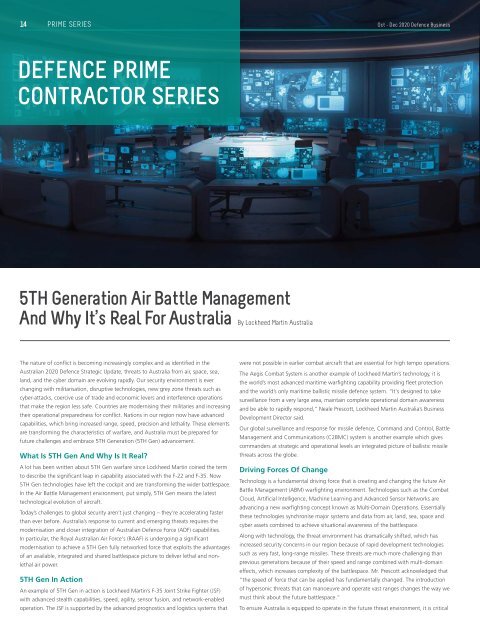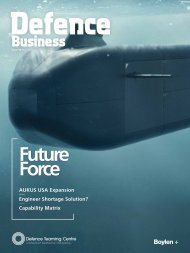Defence Business Issue 52 OCT-DEC 2020
You also want an ePaper? Increase the reach of your titles
YUMPU automatically turns print PDFs into web optimized ePapers that Google loves.
14 PRIME SERIES<br />
Oct - Dec <strong>2020</strong> <strong>Defence</strong> <strong>Business</strong><br />
DEFENCE PRIME<br />
CONTRACTOR SERIES<br />
5TH Generation Air Battle Management<br />
And Why It’s Real For Australia By Lockheed Martin Australia<br />
The nature of conflict is becoming increasingly complex and as identified in the<br />
Australian <strong>2020</strong> <strong>Defence</strong> Strategic Update, threats to Australia from air, space, sea,<br />
land, and the cyber domain are evolving rapidly. Our security environment is ever<br />
changing with militarisation, disruptive technologies, new grey zone threats such as<br />
cyber-attacks, coercive use of trade and economic levers and interference operations<br />
that make the region less safe. Countries are modernising their militaries and increasing<br />
their operational preparedness for conflict. Nations in our region now have advanced<br />
capabilities, which bring increased range, speed, precision and lethality. These elements<br />
are transforming the characteristics of warfare, and Australia must be prepared for<br />
future challenges and embrace 5TH Generation (5TH Gen) advancement.<br />
What Is 5TH Gen And Why Is It Real?<br />
A lot has been written about 5TH Gen warfare since Lockheed Martin coined the term<br />
to describe the significant leap in capability associated with the F-22 and F-35. Now<br />
5TH Gen technologies have left the cockpit and are transforming the wider battlespace.<br />
In the Air Battle Management environment, put simply, 5TH Gen means the latest<br />
technological evolution of aircraft.<br />
Today’s challenges to global security aren’t just changing – they’re accelerating faster<br />
than ever before. Australia’s response to current and emerging threats requires the<br />
modernisation and closer integration of Australian <strong>Defence</strong> Force (ADF) capabilities.<br />
In particular, the Royal Australian Air Force's (RAAF) is undergoing a significant<br />
modernisation to achieve a 5TH Gen fully networked force that exploits the advantages<br />
of an available, integrated and shared battlespace picture to deliver lethal and nonlethal<br />
air power.<br />
5TH Gen In Action<br />
An example of 5TH Gen in action is Lockheed Martin’s F-35 Joint Strike Fighter (JSF)<br />
with advanced stealth capabilities, speed, agility, sensor fusion, and network-enabled<br />
operation. The JSF is supported by the advanced prognostics and logistics systems that<br />
were not possible in earlier combat aircraft that are essential for high tempo operations.<br />
The Aegis Combat System is another example of Lockheed Martin’s technology, it is<br />
the world’s most advanced maritime warfighting capability providing fleet protection<br />
and the world’s only maritime ballistic missile defence system. “It's designed to take<br />
surveillance from a very large area, maintain complete operational domain awareness<br />
and be able to rapidly respond,” Neale Prescott, Lockheed Martin Australia’s <strong>Business</strong><br />
Development Director said.<br />
Our global surveillance and response for missile defence, Command and Control, Battle<br />
Management and Communications (C2BMC) system is another example which gives<br />
commanders at strategic and operational levels an integrated picture of ballistic missile<br />
threats across the globe.<br />
Driving Forces Of Change<br />
Technology is a fundamental driving force that is creating and changing the future Air<br />
Battle Management (ABM) warfighting environment. Technologies such as the Combat<br />
Cloud, Artificial Intelligence, Machine Learning and Advanced Sensor Networks are<br />
advancing a new warfighting concept known as Multi-Domain Operations. Essentially<br />
these technologies synchronise major systems and data from air, land, sea, space and<br />
cyber assets combined to achieve situational awareness of the battlespace.<br />
Along with technology, the threat environment has dramatically shifted, which has<br />
increased security concerns in our region because of rapid development technologies<br />
such as very fast, long-range missiles. These threats are much more challenging than<br />
previous generations because of their speed and range combined with multi-domain<br />
effects, which increases complexity of the battlespace. Mr. Prescott acknowledged that<br />
“the speed of force that can be applied has fundamentally changed. The introduction<br />
of hypersonic threats that can manoeuvre and operate vast ranges changes the way we<br />
must think about the future battlespace.”<br />
To ensure Australia is equipped to operate in the future threat environment, it is critical


















